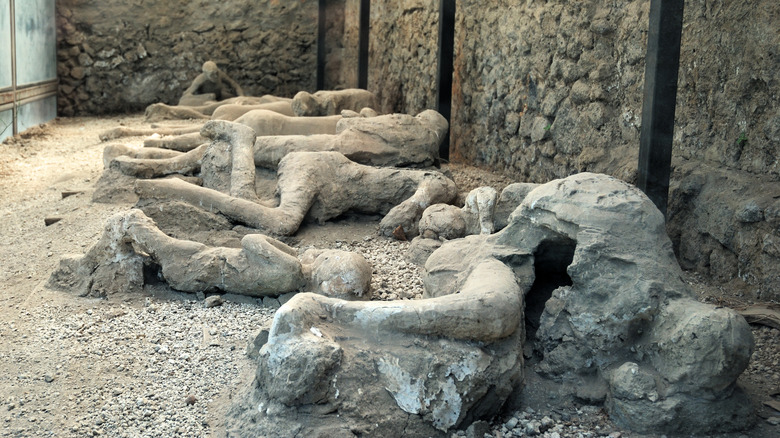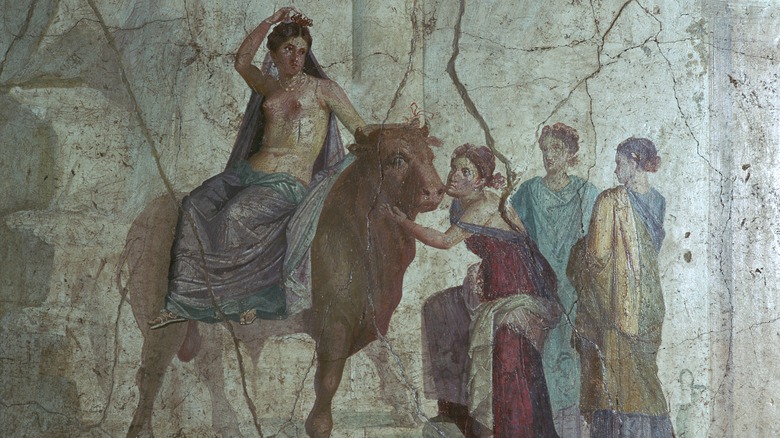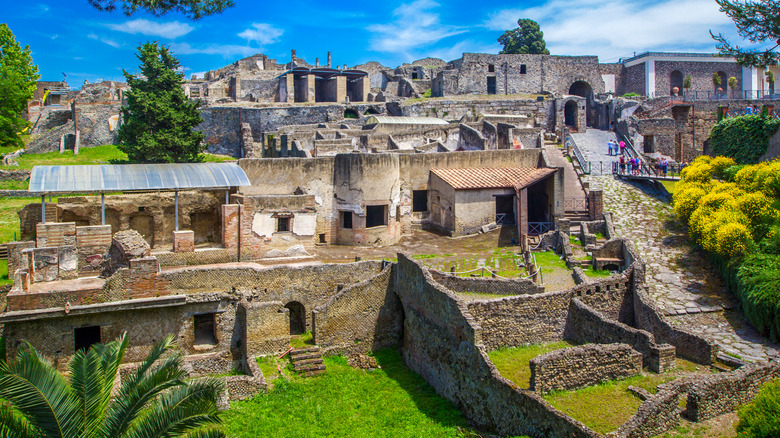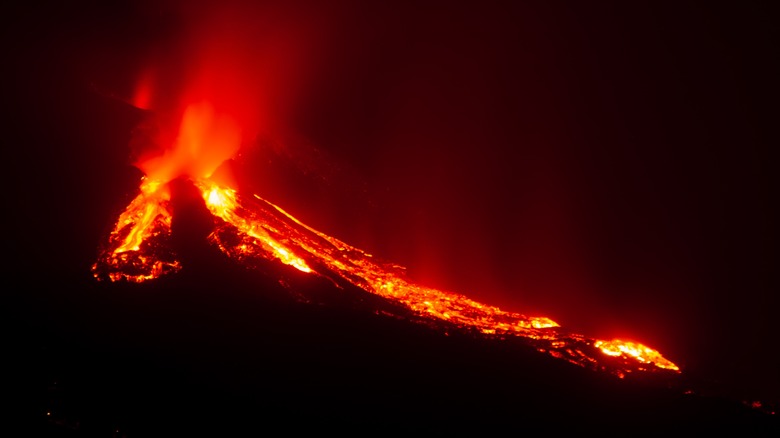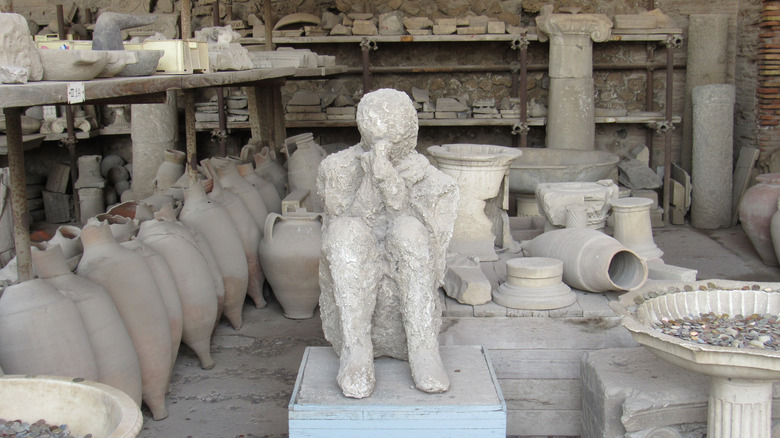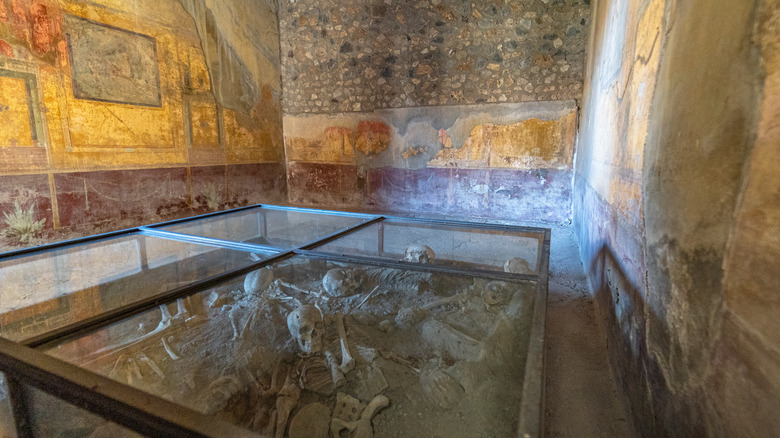What Happened To The Bodies From Pompeii?
The marketplaces and squares of the lively, cosmopolitan city of 12,000 bustled with the usual activity. People filed into bakeries and left carrying bread in their arms. Single-room, fast food restaurants around the town — about 80 in total — served quick and easy fare for passersby: fruit, stews, cheese, fish, spiced wine, and more. Taverns, brothels, factories, artisan shops, cafes, and bathhouses stood ready and active like any day before, as History says.
On this day, though, all these people's lives — the people of Pompeii, Rome — changed in an instant. The nearby volcano, Vesuvius, detonated and suffocated the city and nearby areas in ash and lava. Most people escaped, but about 2,000 didn't. As Live Science says, nearby infrastructure shows evidence of refugee resettlement. For example, professor Steven Tuck said the Sulpicius family carried their safe and financial records with them when they fled. They resettled in Cumae to the west because they knew people there.
Those who couldn't or wouldn't flee got struck by flying stone and buried in pyroclastic flow and ash. The heat was so intense that the New England Journal of Medicine reported one man's brain turning to glass. But the shape of the dead was preserved beneath volcanic matter. And thanks to a plaster cast method developed by 19th-century archaeologist Giuseppe Fiorelli, those shapes remain at the site of the 79 C.E. volcanic detonation, lying in death poses. Only some bones and teeth remain of the people inside.
Lives given voices and shapes
The eruption of Mt. Vesuvius was equal parts horrific tragedy and rare gift to the present. Typically, historical records describe the feats of rulers and happenings of wars, not the everyday lives of those too often beneath notice. The Berkshire Archaeological Society says that literacy in Rome equaled about 15%, but this figure varied wildly from place to place and over Rome's entire history. The people of Pompeii went about their daily lives — lives indistinguishable from our own except for modern woes and conveniences — but had no one to speak for them. The ash and lava of Vesuvius has not given only them voices, but shapes we can see to this day. Such remnants have come at a high cost.
As we mentioned, Pompeii was a thriving city. Located along the modern-day Bay of Naples, History explains that Pompeii became a "flourishing resort" for wealthy Roman citizens. In addition to the aforementioned fast food places, bathhouses, taverns, etc., the city was filled with lavish villas, paved streets, gorgeous artwork, decorative elements like public fountains, and more. Thanks to the eruption we've even got access to surprising elements of daily life like pornographic frescos on walls, and graffiti from the literate. In short, Pompeii was a real place full of real people preserved by the very volcano that destroyed it.
An asphyxiated witness
Even though the preserved remains of Pompeii tell much of what happened in 79 C.E., we also have a single eyewitness account from the day from Pliny the Younger, nephew of renowned Roman scholar Pliny the Elder. All in all, the people of Pompeii had warnings leading up to the eruption. In fact, the American Museum of Natural History describes earthquakes striking the region for a full 17 years beforehand. But once Vesuvius finally blew, those who didn't heed the signs had no time to escape. It's the swiftness of the volcanic fallout that sealed both the fates and bodies of Pompeii into place.
In two letters to Roman politician Cornelius Tacitus, Pliny the Younger wrote about his uncle, Pliny the Elder, dying from presumed asphyxiation as he rushed toward Vesuvius to save friends and family. As Pliny the Younger writes and Pompeii Tours cites, pine tree-shaped smoke rose from Vesuvius and spread like branches at the top. It was "sometimes bright and sometimes dark and spotted" and full of "earth and cinders." "Black pieces of burning rock" struck the area and the mountain, which grew "thicker and hotter" the closer Pliny and his entourage got. They even tied pillows to their heads to protect them from falling rocks.
After getting separated, Pliny writes that his uncle's body "was found entire, and without any marks of violence upon it, in the dress in which he fell, and looking more like a man asleep than dead."
Swallowed by lava and ash
It took a precise sequence of events to grant us the casts of Pompeii's victims shaped precisely like their bodies when they died. Pompeii Sites says that the eruption came in phases. The first phase was described in part by Pliny the Younger and consisted of lots of pumice stones falling from the sky. These smashed through roofs and hit people directly, or caused debris to hit people. Many, if not most, died during this phase, as the total debris reached almost 10 feet high.
Those who died got swallowed by lava, or more specifically, pyroclastic flow — a combination of hot ash, chunky lava, searing gas, and pumice. Pyroclastic flow can move up to 50 miles per hour and reach up to 1,300 degrees Fahrenheit. Then, preservation required a critical step: being covered in a blanket of ash. This ash kept the forms of bodies intact even after their biological matter deteriorated to nothing but teeth and bones. The BBC says that this ash — plus whatever other materials landed in the layer of lava and pyroclastic flow — solidified and hardened into place, ensuring preservation over time.
The shapes of the dead don't only portray their torsos, limbs, or even facial expressions. Some of them even depict people's clothing, like the dress of a young woman twisted around her waist and lifted above her legs. It's a stunning, sometimes ghastly, and awe-inspiring reminder of mortality.
Given forms of plaster
The plaster casting process was a simpler, but exceedingly clever process. In the 1860s, Pompeii's excavators started coming across pockets of space beneath the site's hardened lava and ash. Sometimes the pockets contained bones, sometimes not. Naples-born Giuseppe Fiorelli developed a method for boring holes down to cavities and pouring plaster into the hole to fill out its shape. His method also worked for everyday objects, animals, plants, and so forth.
Pompeii Sites says that over 1,000 bodies have been unearthed since 1863, and over 100 of them were made into casts. Despite being a world-famous, 160-year-old archaeological find, Pompeii Sites also explains that Pompeii's entire excavation is "still in its early stages." Authorities are moving slowly so as to not damage the site, because, as site director Gabriel Zuchtriegel says, "Excavation is an unrepeatable event. What is excavated remains so forever."
Most of the casts have been moved from their original positions, and many placed behind glass. Thirteen casts, however, have remained precisely where their makers died at a location called Garden of the Fugitives. As Pompeii Sites explains, these 13 victims died trying to escape a wine vineyard and outdoor banquet space. They couldn't exit the nearby gate because stone blown out from Vesuvius had already reached almost 11.5 feet, and they were swallowed by a pyroclastic flow. Thermal shock killed them instantly.
Ongoing excavation and tourist site
At present, Pompeii is open and available for the public to visit. The BBC describes how many visitors don't seem to know that the curled, prone, pained, and chalky white forms that they're looking at aren't the actual bodies of victims somehow turned to stone. The real bodies are long gone, and what remains is a tactfully-obtained imprint of their final moments left in the lava that consumed them. The site does contain some bones mixed with long-hardened plaster, but no desiccated flesh like a mummy. Archaeologists continue to find skeletal remains throughout the site — ones unconnected to plaster casts.
Folks interested in planning a trip to Pompeii have loads of options to choose from. Statista shows us that pre-COVID-19, almost 4 million people visited the site in 2019. By 2022 the number had gotten back up to about 3 million. Sites like Pompeii Tickets list opening hours, the best months to visit, how to arrive from other parts of Italy, on-site facilities like toilets, cloakrooms, and restaurants, and some key locations around the site, like the Temple of Apollo. Meanwhile, sites like Along Dusty Roads provide an essay-like history of the site plus information about itineraries. But no matter how you approach Pompeii, or if and when you choose to visit, be prepared to meet some ghosts. Victims' bodies might be gone, but their imprints linger.
